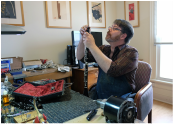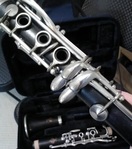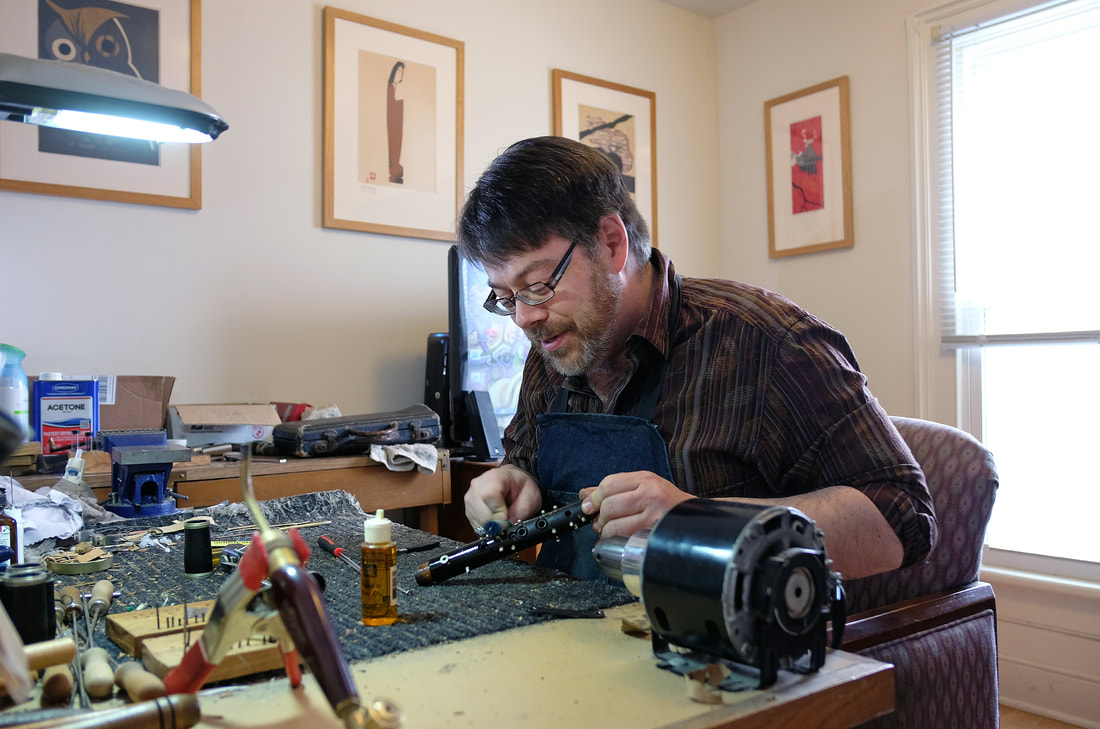 For the many years before the Vintage Clarinet Doctor did repair, I'd turn one of my instruments over to a repairman with mingled optimism and dread. Does he know what he's doing? What does 'overhaul' really mean? Why does one person charge significantly more than another? Are there any approved procedures or industry standards, or does anything go? I'd like to address a few of those concerns and try to shed light on some of the mysterious things that a good tech does (or should do) to a horn. On a newer plastic student horn, a re pad might only include dis-assembly, washing the body, quickly hand-ragging the keys, replacing missing corks, replacement of all pads, reassembly and adjustment: about a 2 1/2 hour job for about $150. For an instrument with fresh tone-holes, snug posts, tight mechanism, shiny nickel plated keys and recent springing this might be sufficient, especially if its going into the hands of an 11 year old of indifferent ability. An overhaul, on the other hand, would include everything necessary to return the instrument to as close to 'like new' playability as is feasible (sometimes extraordinary measures are not justified by the value of the instrument), and address the preferences of the more advanced player in question. This might include: Swedging/countersinking the key-work to remove lost motion, re-facing of tone-holes to assure optimal pad seat, tightening of posts, replacement of all cork (including adjustment of opening height to regulate tone and intonation), thorough oiling of body, buffing of body, posts and keywork, polishing of the bore, straightening or leveling of bent keys, key cups and rods, realignment of keys with tone holes, replacement of weak springs, repair of small cracks or chips, installation of a mix of high quality double bladder/leather and cork pads, reassembly and adjustment, overnight clamping, and re-gilding the logos! Total of 6-10+ hours depending on age, complexity of mechanism, and condition. To Be Continued....
0 Comments
 In my 10 years of clarinet restoration, I've dealt with a lot of old clarinets and, naturally, a lot of Buffets. As one of the most expensive clarinets out there, and one of the most highly regarded, I'm amazed at the plating problems that I've seen in instruments dating from the 1960's forward! Buffets from WWII, WWI and even earlier restore beautifully: their solid nickel alloy keys buff to a warm glow and retain it well, even with regular use. The Buffets from the 60's forward on which I've worked show almost unvarying moderate to severe plating wear and, in the case of one from the 80's that I saw recently, even peeling from plating that failed to bond to the base metal - and this on a clarinet in A that must've cost someone the price of a decent used car! I frequently work on Conn Pan American clarinets from the 40's and 50's - you know, the colorful ones made of cocobolo plywood when granadilla was in short supply? They are great playing horns, rarely crack, have locking screws tapped into the posts to help keep the main screws from backing out and, oh yes, plated keys. Except the plating is rarely worn through, in my experience, and this on a 'student grade' horn built 20-40 years before the average Buffet with plated keys! What was Conn's secret and can Buffet figure out how to copy it on newer horns costing far more? I'd be interested to hear from others with experience with this problem as to the cause of this and why Buffet has felt justified in doing this level of work on what are advertised and regarded as pro instruments? If I were to sell a customer a recent production Buffet, I'd like to know that it would still look good when I retire. Generally, I recommend a Penzel Mueller instead.... Grenadilla wood is the most common wood for manufacturing clarinets but, the question is indeed, why?
The first clarinets were made of boxwood and fruitwoods which were easily accessible. The issue with these woods is that they are soft and do not weather well with age and changes in temperature and humidity. The life of a clarinet is, of course, being soaked with saliva and then dried. These woods warped, split and broke from standard use and the climate. It is no wonder woodwind instrument manufacturers switched to harder woods. Moving forward, grenadilla came into use as a hard and easy to work with wood. When this wood came into popular use, the general population had no concerns about cutting down large quantities of trees, even if they did not grow back quickly. Today, there is fewer sources of this wood, and the demand is greater than ever before. Why? Grenadilla gives a nice rich sound for which the clarinet has become known. A very thick walled clarinet will generally give a slightly “darker” or “richer” sound while a thinner walled instrument will give a slightly “brighter” or “sweeter” sound. It is also a great wood because it is able to withstand the changes in weather extraordinarily well and, because of this, there are many instruments are well over a century old and still being played. Today, more exotic woods are used to make clarinets, particularly harmony clarinets, and accessories such as barrels and bells. These woods are most commonly cocobolo and rosewood but, there are many other woods that are used. The problem with these woods is that they are expensive and harder to obtain. The upsides are they have slightly different tonal properties and are visually pleasing. Clarinets evolved from boxwood to grenadilla (along with metals and plastics in between) with barrels and bells of exotic woods. Manufacturers and makers continue to rethink the setup and acoustic design of clarinets but, the backbone is the imperfect grenadilla. - by Jarrett Rodriguez |
Archives
February 2024
AuthorThe Licorice Shtick Blog is the creation of the Vintage Clarinet Doctor, a Winston Salem, NC based woodwind instrument repair shop specializing in vintage and antique clarinets, saxophones, and the occasional flute. Categories |

 RSS Feed
RSS Feed